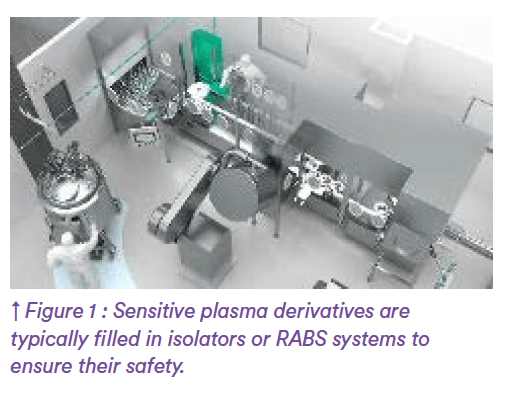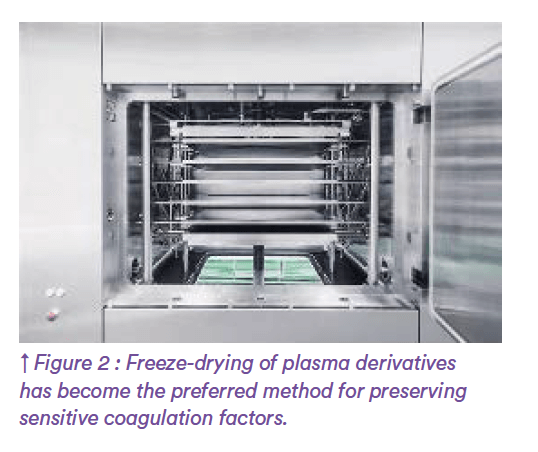Sommaire
- La restriction des PFAS dans l’industrie : enjeux réglementaires et impacts sur l’industrie pharmaceutique
- La technologie Blow-Fill-Seal dans l’industrie pharmaceutique : performance, applications et durabilité
- Key Allies in Preventing Contaminants and Impurities in Bioproduction
- Choosing the right vial: packaging sterile drug products with foresight
- Combination Products in the United States and European Union: Differences and proposed strategy to prepare common CTD Quality Module 3
- Blood plasma processing. When every drop counts
- L’analyse de la normalité en Continued Process Verification
- Qualification of impurities
- Pharma 2052
Blood plasma processing. When every drop counts
Human blood is a vital resource in many respects. It plays a crucial role not only in transfusions, but also as a component of specific medicines. So-called plasma derivatives, which are obtained from human blood, support the treatment of various diseases – from hemophilia and antigen defects to Covid-19. The products are in high demand and their manufacture involves complex processes. Precision throughout the value chain helps ensure that patients get the most out of every drop.

Although red at first glance, roughly 55 percent of human blood consists of a whitish-yellow liquid: plasma, the fluid in which white and red blood cells and platelets move through the body. What is essential for the human body proves to be advantageous from a pharmaceutical standpoint: blood plasma can be used to produce life-saving drugs due to its wide range of components, which include important proteins such as albumin, which is used for sepsis and burns, as well as immunoglobulins. These antibodies are primarily used to treat innate antibody defects, but also diseases such as Covid-19.
Products with potential
The market for blood plasma derivatives is growing and is expected to reach a volume of around USD 53 billion in 2024. The reason: high demand, which is, among others, driven by advances in medical technology. More and more compounds can now be produced recombinantly, i.e., through genetic engineering, and no longer require donated plasma. Technologies for fractionation – splitting plasma into its components – have also evolved. Continuously operating centrifuges, for example, and production-scale chromatography support more efficient production processes. This in turn results in higher yields of valuable proteins such as albumin, immunoglobulins, and coagulation factors, paving the way for more versatile therapeutic options. Regardless of recent medical advances, blood coagulation disorders, rare genetic defects, and immune diseases are on the rise worldwide, increasing the demand for plasma derivatives. Type 1 diabetes, rheumatoid arthritis, and multiple sclerosis have spread rapidly since the late 1980s, especially in Western countries. The U.S. is the central market for blood plasma: while roughly eight million liters are collected in Europe every year, the U.S. covered around 65 percent or 38 million liters of global demand in 2020.
From raw material to medicine
Before plasma can be transformed into safe and effective medicines, the raw material has to go through several stages of processing. Manufacturers normally receive donated raw plasma in frozen form. It is then thawed, fractionated, purified, formulated, filled or freezedried, inspected, and in some cases pasteurized. Due to the complex nature of production and the limited availability of human plasma, pharmaceutical producers must ensure precise and reliable processes. Plasma loss is not only costly; it also means wasted therapeutic opportunities. In addition to high yields, flexible processes that deliver safe, high-quality products are paramount.
Customized thawing and fractionation
The frozen plasma that pharmaceutical manufacturers process is shipped in large bags or bottles containing donor material from several sources. Before fractionation, the raw plasma must be thawed gradually to avoid harming the temperature-sensitive proteins. This is done in specialized systems with mixing tools that exert low shear forces on the material and gradually raise the temperature. After thawing, the raw material is ready for fractionation, i.e., split into components such as albumin, immunoglobulins, and fibrinogens, which are among the coagulation factors. The fractionated plasma then undergoes several filtration steps that separate the target molecules according to size, electrical charge, and chemical affinity. This highly complex step requires equipment that offers efficient and stable large-scale fractionation. All-in-one solutions from a single source form the basis for a seamlessly integrated, fully automated system infrastructure with continuous monitoring of critical parameters. Each extracted fraction must be stored and purified separately. Impurities and viruses are degraded chemically or using heat, while the concentration of each future active ingredient is increased. Various excipients including stabilizers are added to the fractions during formulation, while stabilizers ensure that the fractions remain effective throughout the subsequent process. A robust infrastructure for pure media complements these steps and enables a reliable supply of pure steam and purified or highly purified water.
Gentle and precise dosing
Plasma derivatives are mainly filled in glass vials of varying volumes, typically ranging from 2 to 500 milliliters, which are used for liquid and freeze-dried products alike. The demand for flexible filling systems that can accommodate different vial sizes and deliver precise filling volumes is high. Modern technologies rely on multi-stage filling and weighing processes to achieve high filling accuracy even with fast changeovers. Peristaltic pumps, which are particularly suitable for shear-sensitive proteins such as coagulation factors, are first used to fill 95 percent of the product. The remaining 5 percent is filled in a second step – with a smaller filling needle and within more narrow tolerance limits. This main dosing and subsequent dosing make it possible to determine the optimal filling weight with 100 percent in-process control (IPC) and to achieve precisely dosed plasma derivatives. Moreover, advanced filling systems can avoid underfilled vials. If the weighing process reveals that certain containers do not yet hold the required amount of product, the filling needles swing to the corresponding containers to top them off.
Isolators for optimum aseptic conditions
Sensitive plasma derivatives are typically filled in isolators or RABS to ensure their safety. Both approaches to separate operating personnel and products have become even more important in light of the revised version of EU GMP Annex 1. In terms of aseptic production, Annex 1 explicitly recommends both technologies in combination with a higher degree of automation to increase the quality of medicinal products. This includes effective bio-decontamination prior to the actual filling process. Isolator systems from leading manufacturers use vaporized hydrogen peroxide (H2O2) as part of a multi-stage process that includes preparation, conditioning, and aeration in addition to bio-decontamination. The goal is six-log reduction of the biological indicator organism. The residual concentration should be less than 1 ppm (part per million), as proteins react sensitively to vaporized hydrogen peroxide; residual concentrations lower than 1 ppm can also be achieved.
Fail-safe freeze-drying
Freeze-drying of plasma derivatives is characterized by long processing times. This alternative to the liquid dosage form has become the preferred method for preserving sensitive coagulation factors. Cycle times of several days are a common requirement for this production step, which makes it all the more important to ensure safe, monitored processes. Systems with redundant and high-quality components support fail-safe production. Modern freeze-dryers also rely on sophisticated, state-of-the-art sensor technology to keep key process parameters such as temperature and pressure stable. Advanced systems with optimized secondary processes such as CIP, SIP, filter sterilization, and WIT can save energy, time, and media.
Inspection for maximum product quality
Freeze-drying is followed by another important step: the visual inspection of liquid or lyophilized products, checking for the presence of particles and cosmetic defects, and container closure integrity testing (CCIT). State-of-the-art inspection systems efficiently combine the two processes on a single platform. Leak testing for lyophilized products is carried out using headspace analysis (HSA).
Pasteurization in keeping with strict criteria
Some products require pasteurization, during which they are processed as gently as possible in tightly sealed containers and within strict temperature limits. As a rule, plasma derivatives are pasteurized at 60 degrees Celsius (140 degrees Fahrenheit), with deviations of only half a degree (approx. 32 Fahrenheit) permitted over a period of up to twelve hours. In addition to flow-optimized pasteurizers with corresponding baffles, suitable processes are key to maintaining the right temperature. The steam-air mixture principle provides a homogeneous flow through the pasteurizer by ensuring consistent conditions over extended processing times and within a narrow temperature range. The ideal system configuration can be determined by simulating the process and comparing it with real values, an aspect that makes equipment manufacturers’ process expertise particularly important. These manufacturers involve customers in the analysis and design at an early stage. The same applies to the entire process: by working together closely from the outset, pharmaceutical companies and equipment manufacturers can define and implement optimum systems for precise processes throughout the value chain – so that patients gain the most from every drop of the precious plasma derivatives.







